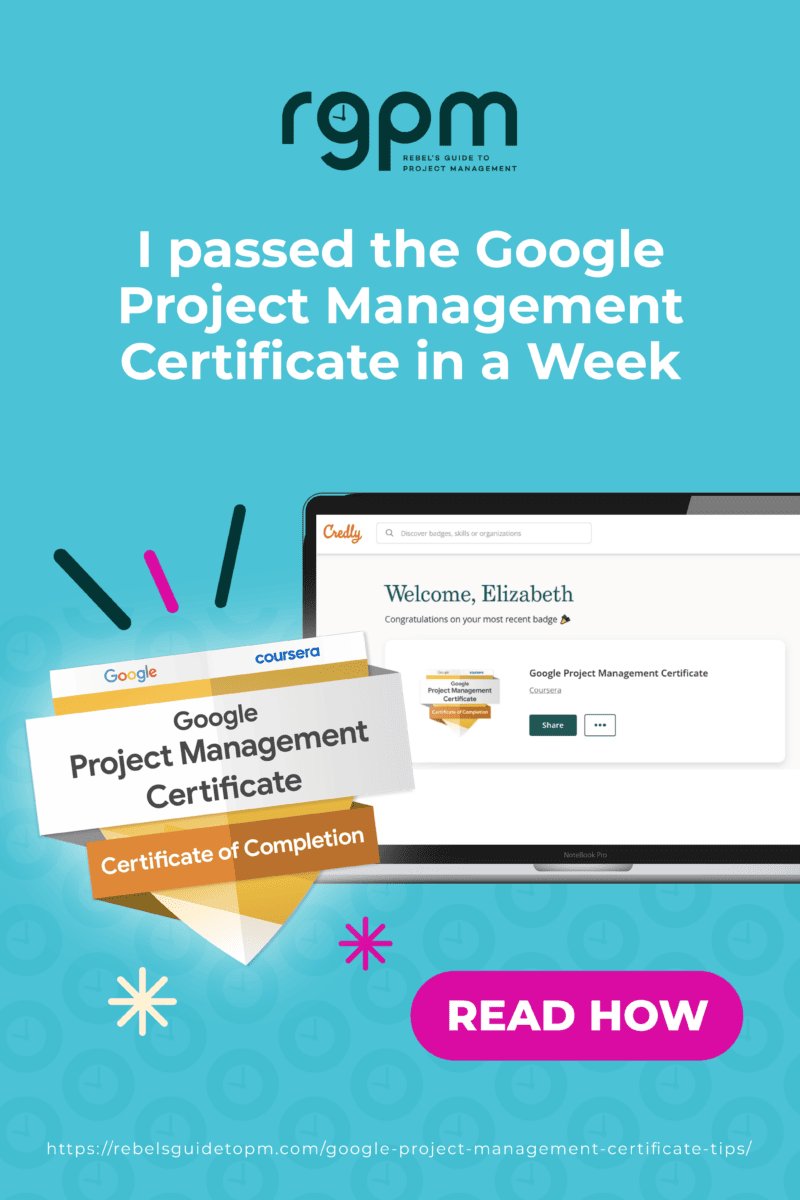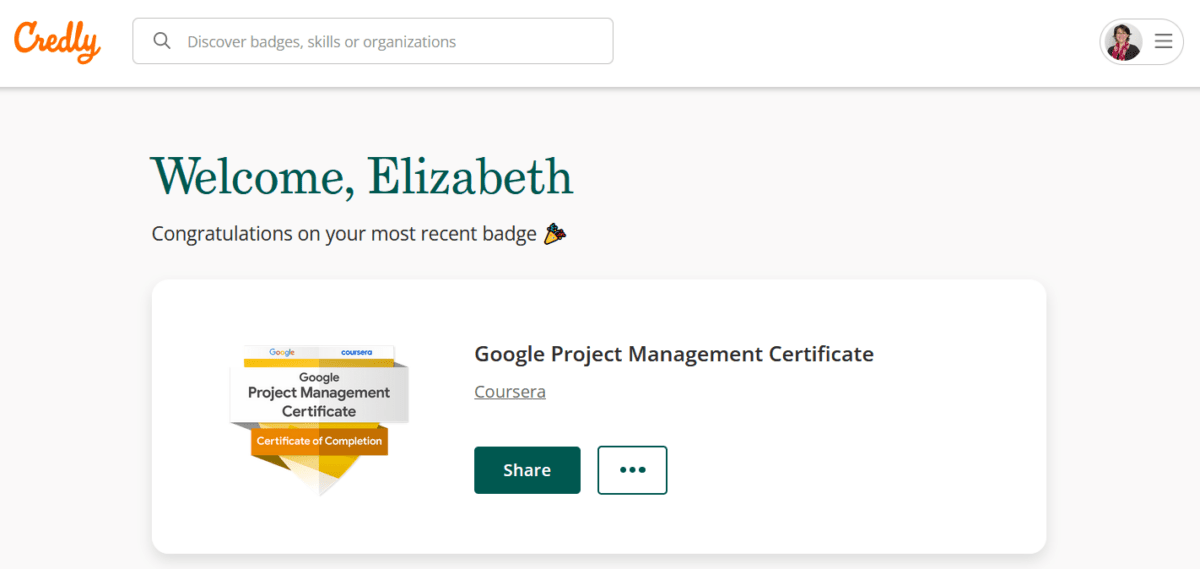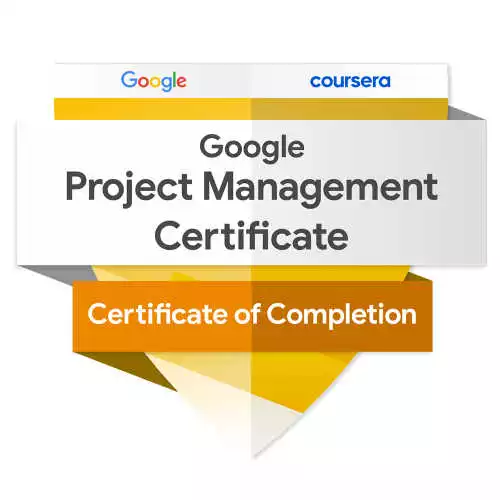How I passed the Google Project Management Certificate in a Week
This blog is reader-supported. When you purchase something through an affiliate link on this site, I may earn some coffee money. Thanks! Learn more.
Read our review guidelines.
Are you looking for tips on how to pass the Google Project Management Certificate? I completed the 6 courses in a week (what a week that was!).
I don’t remember the last time I was so stressed as I was working full-time at the same time, but I did it, and you can too.
In this article, I’ll share my top tips for working out the answers to the graded quizzes, how to plan your time and how to get the certificate for the lowest possible cost (not free, but very cheap).
My experience with the Google Project Management Professional Certificate
I completed the course requirements in a week. I signed up for the Foundations course and completed that on Day 1, and then on Day 7 I had all the peer reviews back for the Capstone and got confirmation that I had passed the certificate.
The week was incredibly busy and I didn’t do much else aside from work through the course materials and complete assignments (outside of the hours I was actually doing my day job).
A solid, professional, well-recognized project management course from a great training provider. Perfect for beginners and people interested in learning more about project management as a career.
How I did it so quickly
I have 20+ years experience in project management, so I am definitely not a beginner. The Foundations module, for example, was really easy for me, and I whizzed through that. The more experience you have working in a project environment, the easier it will be for you.
The less experience you have, the more time you’ll have to spend as all the concepts will be new to you. I spent most time on the
I worked on all the courses at the same time, pretty much, after I completed the Foundations.
If you have some experience…
If you have project management experience, don’t watch the videos. Scan the transcript instead. Skip any topics you know well and go straight for the quiz. If you pass the quiz, assume you have enough knowledge to miss that topic and save yourself time.
How I did it so cheaply
Coursera works on a subscription model for the
First, I signed up to audit the courses. Then I had a good look around the course materials for free. You can watch the videos, review the readings and download the templates without paying anything.
That gave me a good indication that I wouldn’t have to spend the recommended 6 months on the course, and that I could indeed do it quickly (and therefore cheaply).
You only have to sign up as a student and start paying when you commit to earning the certificate for real, as you have to be subscribed to be able to submit graded assignments and quizzes, and peer-reviewed assignments.
Pro tips to save money
Sign up to audit the course first, and then convert to a paid student when you are sure you have the time to commit to doing the assessed work.
If you are offered a free trial, you can also take that and do as much of the course as possible in the free trial period.
Tips for passing the Google Project Management Certificate
So what did I learn from the experience? And what tips do I have for you if you want to earn the certificate as cheaply and quickly as possible? Read on…
1. Make a tracker
There are 6 courses to do in the
Because of the speed I was going through the materials, I needed a tracker. I just wrote out a list of the courses and modules and made a note of what still needed to be done on them. It kept me focused on what was missing, what assignments I needed to submit (or resubmit) and made it easy to go straight to what needed doing when I had a spare moment.
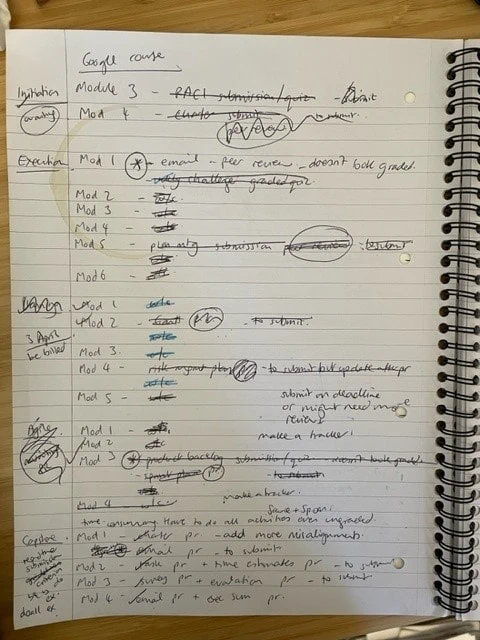
2. Submit on or before the deadline
Each assignment and graded quiz comes with a deadline.
The deadlines are auto-calculated by the looks of it, from the Coursera platform. I first thought they were there simply to help you pace yourself and make sure you didn’t give up on the material.
However, there is some small print I read that said if you submit a peer-reviewed assignment after the deadline you might need more than one peer to review it. If you submit on the deadline, you only need one reviewer.
Don’t wait for extra reviews: submit on time so you aren’t reliant on other people.
3. Note your correct answers on quizzes
You might fail a quiz (I certainly did) but that doesn’t mean you got all the questions wrong. Some quizzes keep the same set of questions when you do them again, so note down the answers you did get right.
Also note down which answers were wrong. The tests are all multiple choice so you don’t want to select the wrong answer again.
When you take the quiz again, use your notes to make sure you don’t accidentally get an answer wrong again, and put in the correct answers.
4. Use the search
Timed quizzes can be stressful, but you get 50ish minutes per quiz which is a lot of time to answer 10 questions.
If you can’t work out an answer, use the search feature. Copy/paste one of the answer responses or a key word from the question into the search bar. Use a new window or tab, not the one your test is open in.
Then review the search results. You’ll often find that the answer to the question is in the course material (I mean, why wouldn’t it be??). Then you can confidently choose the right answer.

5. Watch the videos on 1.5x speed
Watch the videos on fast speed. As long as you can still understand the tutors, you’ll be fine. This will help you get through the material more quickly.
6. Do the courses in any order
Do you have to take the
I did them all pretty much in parallel, leaving the Capstone until last.
7. Don’t review the job seeking content unless you are job seeking
I know this is going to sound obvious, but if you aren’t currently looking for a job, skip all the sections on job hunting, interview prep and resumes/CVs.
You can also skip the Googlers telling stories about their career paths. They are interesting, but they aren’t crucial to being able to apply the knowledge. If you have loads of time, by all means watch them, but if you are speeding through the content, you can skip them comfortably.
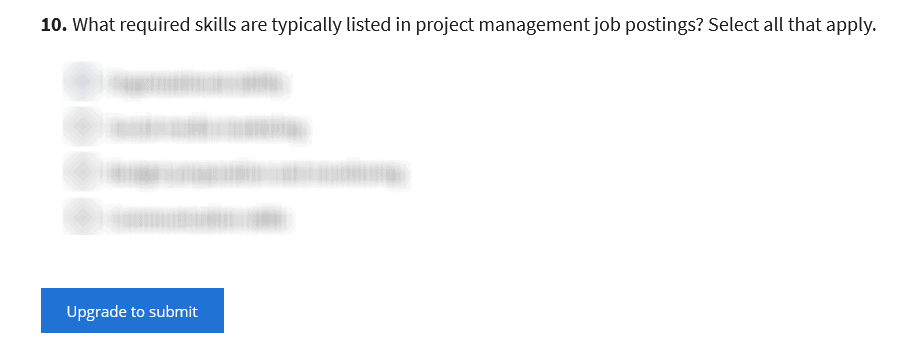
Tips for the Google Project Management peer-reviewed assignments
Most of the courses have peer-graded assignments. For example, you have to complete a project charter, a risk document, a presentation to executives, write sample emails etc.
The example project is Plant Pals (the Capstone project is Sauce & Spoon), and actually it’s quite fun to work through creating project documents. The case study is realistic and well-put together, you will definitely find it useful if you have not worked on a project end-to-end before.
Here are some tips for acing your peer-reviewed assignments.
1. Make sure your file is publicly accessible
You have to review other people’s work as well as submit your own, and overall, the quality of the files submitted was poor. There were quite a few that I couldn’t even access because the
Make sure people can access your file!
2. Load the right file
You are given student documents to review, and there were several I was given where I had to flag that they had loaded the wrong file. One was even a promo leaflet for some guy’s training courses. Some people loaded the blank template.
Don’t waste your time (or other people’s) by loading the wrong documents. Come up with a naming convention for all the files you will create and then upload the correct version.
I made this mistake once myself. There are two exercises where you have to write emails and I uploaded the wrong email file for an assignment. Believe me, when people score your assignment as 0/10 and you fail, it really stings!
3. Read the submission criteria
Each peer-reviewed assignment where you have submit a file has two tabs. One tab is your instructions, the next is the upload screen where you share your file so it can be reviewed.
On the upload screen you will see submission criteria. This is basically a list of what the reviewer will be looking for.
Read this before you spend time creating your file so you know exactly how you will be graded and what you need to include in the project documentation.
4. Remember to review other people’s assignments
You won’t be marked as ‘complete’ unless you have reviewed other people’s assignments as well as submitted your own and had that reviewed.
It doesn’t take long to look over someone else’s document, especially as you have just written one on exactly the same template. You will be given a marking scheme so you know exactly how to assign marks.
Put some time aside as soon as you have submitted your assignment and just get through them. You’ll know when you have done enough as it will invite you to review more, but you are not obligated to.
5. Keep them short
It’s tempting to write loads and loads in the project charter or other documents, but you really don’t have to. Stick with a few bullet points that cover the key content.
In real life you might want to add more context and more words, but generally short is good. There are only certain things that will be graded anyway, so any text you put in additional boxes is not going to score you extra.
That’s not to say you shouldn’t do a good job, especially if you are hoping to get the practice of putting together project documentation – useful if you want to become a project manager. But if you want to get through the course fast, do the minimum required and don’t gold plate your assignments.
Tips for the Google Project Management Capstone Project
The Capstone course (Applying Project Management in the Real World) is the Sauce & Spoon case study, which is a fun project about rolling out a new system for a group of restaurants. It feels timely and relevant, with a cast of characters you’ll come to feel like you know.
You are the project manager, and the goal is to shepherd the project through from idea to delivery – which of course you manage to do just fine.
Here are some examples of the
- Create a project charter
- Draft emails
- Identify project tasks and put them in order with milestones
- Identify and create time estimates for a project plan
- Identify quality criteria and establish how these will be measured
- Create a presentation to share project results
- Draft an executive summary
The Capstone also includes a section on preparing for an interview, which you don’t have to do.
Here are some tips to stay on top of the Capstone (and there are even more tips in this article on how to pass the Capstone).
1. Pace yourself
It was a lot more work than I was expecting. There are 8 peer reviewed assignments which equals 8 documents to create, submit, and then review someone else’s submission.
Given that I am an experienced project manager who had breezed through the other content, I figured I would also find it easy.
It wasn’t hard (for me), but you can’t skip sections. It is time-consuming so make sure you have time put aside.
2. Do the ungraded assignments
I thought I would save myself time and skip the assignments that are ungraded, focusing instead on the peer-graded projects instead.
I quickly found that you can’t do that. You open a peer-reviewed assignment brief and it says, “Take the project charter you created earlier…” and if you haven’t created one earlier you have to go back and do it from scratch.
You need to work through all the activities, even the ungraded ones. There is important case study information and ground work that you cannot skip.
3. Don’t stress about people being available to review
I was really worried that no one would be online or available to review my assignments. What if no one else was studying at that time? What if I was the only one in the whole world completing the Capstone and I’d have to wait for someone new to enroll so they could mark my work?
All those worries were completely unfounded. There are plenty of people going through the same experience. I was reviewing papers uploaded just that day, and people were reviewing mine within hours.
The longest I had to wait was about 18 hours. I went to bed worried no one would see my paper and in the morning it had been graded.
4. Look for the Capstone answers
All the answers are in the case study. You don’t have to make anything up (although you can embellish if you want). Just read the materials carefully and write down what you learn.
You don’t even have to infer or deduce. I think every answer and expectation is there in black and white on the screen. For example, success criteria and KPIs, they are written in the case study materials.
I’ve never had a project meeting in real life where a sponsor has said, “We’re looking to improve turnaround time by 5% and reduce customer waiting time by 30 minutes.” But the Sauce & Spoon stakeholders are very switched on and articulate! In real life, expect to have to gently coax senior managers to come up with numbers they can be held accountable to!
5. Do the work
I wonder how many people start the 6 certificate courses and then get to the Capstone and think, “Whoa, that’s a lot of work.” And then drop out.
Don’t let that be you. You can do it. There is no time limit on taking the course, and if you show up and do the work, you will pass.
The Capstone is a lot more work than any of the other courses. I think there are only 5 peer-reviewed assignments in the whole of the rest of the course, and while that gets you used to the process and the expectation, the Capstone takes it to a whole new level.
That’s the point, after all. They want you to feel confident and to ‘see’ a project from start to finish.
Before you go…
You can definitely pass the
You earn a Credly badge at the end of it, which makes it all worthwhile.
I did have a stressful week, so I wouldn’t recommend doing what I did and cramming the course, but I do think the course was good and worthwhile. Read my full review of the Google Project Management Certificate.
If you have read this because you are considering signing up, I’d recommend it. If you’ve got to the end of the article because you’re halfway through the course and need the motivation to keep going… keep going!! You’ve got this!
Other articles that might help:
- Are Google Career Certificates worth it for getting hired? (Spoiler: Yes!)
- Tips for getting a job with the Google PM Certificate
- Google Project Management vs PMP: Which one should you choose?
- Google Project Management vs the IBM Project Management certificate: Which is best?
A solid, professional, well-recognized project management course from a great training provider. Perfect for beginners and people interested in learning more about project management as a career.
